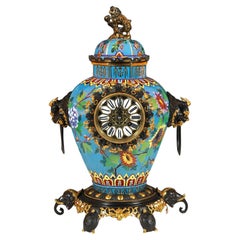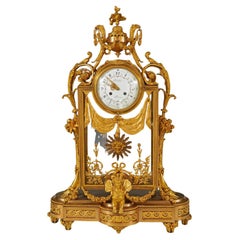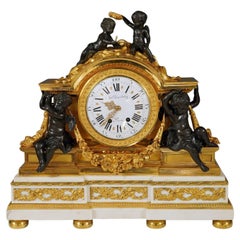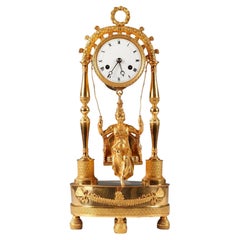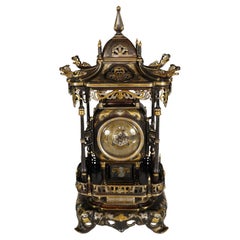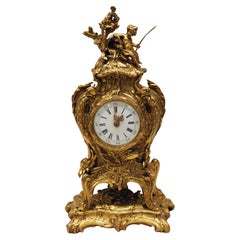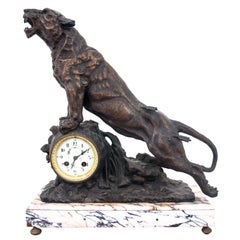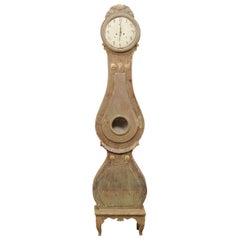Tobogan Antiques Clocks
to
3
17
16
1
1
1
4
16
15
5
5
5
17
17
15
2
2
Height
to
Width
to
17
17
17
1
1
1
1
1
L'Escalier de Cristal, Oriental Clock, France, circa 1890
By L'Escalier de Cristal
Located in PARIS, FR
Rare Chinese style clock in the shape of a covered pot, in porcelain painted in imitation of Chinese cloisonné enamel and decorated with a two-patina bronze mount. The dome-shaped co...
Category
Antique 1880s French Chinoiserie Mantel Clocks
Materials
Bronze, Enamel
G. Denière, "Pendule à cage", France, circa 1860
By Henri Picard, Guillaume Denière
Located in PARIS, FR
Large and rare Louis XVI style cage clock in chiseled and gilded bronze, rectangular in shape, highlighted with friezes of water leaves and pearls, with glass panels decorated with t...
Category
Antique 1860s French Louis XVI Mantel Clocks
Materials
Bronze
$45,833 / item
A-E Beurdeley, « The Coronation of Science » Clock, France, circa 1880
By Emmanuel-Alfred Beurdeley
Located in PARIS, FR
Signed on the dial A. Beurdeley Paris
Mechanism signed J LEFEBVRE FILS PARIS
Rare Louis XVI style clock in mercury-gilded and patinated chiseled bronze and white marble. In the form of an arched pediment, it is decorated with four Cupids, two carrying a garland of flowers highlighting the dial, and two others symbolizing the coronation of Science. The molded base in white marble, with a double recess, is decorated with a ribboned torus, a frieze of ribboned oak leaves and interlacing, and rests on six flattened ball feet.
Related work :
In 1774, the bronze-caster Robert Osmond (1711-1789) designed a first model known as “architectural drawing” illustrating The Coronation of Science. Also called The Children of France, it is decorated with a putti crowning a young girl drawing with a compass and delivered to Versailles by Lépine, clockmaker to the King since 1762, for the apartment of Madame Royale in the Princes’ Wing, on December 28, 1778. (see photo attached)
This clock is described in the inventory of Versailles clocks...
Category
Antique 1870s French Louis XVI Mantel Clocks
Materials
Marble, Bronze
Ormolu Clock "with a Swing", France, circa 1820
Located in PARIS, FR
Very fine floral and decorated Restauration period ormolu clock, figuring two baluster columns joint together by a floral arch, and topped by a crown of roses. Roman numbers indicate...
Category
Antique 1820s French Restauration Mantel Clocks
Materials
Bronze
"Pagoda" Clock attr. to L'Escalier de Cristal, France, circa 1885
By L'Escalier de Cristal
Located in PARIS, FR
Beautiful Japonisme clock in openwork patinated bronze with gold and silver highlights in the shape of a pagoda, at the corners presenting stylized dragons above uprights imitating b...
Category
Antique 1880s French Japonisme Mantel Clocks
Materials
Bronze
"The Source" Gilt bronze Clock attr. to L. Messagé & F.Linke, France, circa 1890
By François Linke
Located in PARIS, FR
Charming clock in the shape of a Rocaille-inspired cartel in chiseled and gilded bronze. Scalloped marine-inspired decor representing a trophy with oars, dolphins, reeds and flowers ...
Category
Antique 1890s French Rococo Revival Table Clocks and Desk Clocks
Materials
Bronze, Enamel
Neo-Egyptian Marble Clock Attributed to G. Servant, France, Circa 1870
By Georges Emile Henri Servant
Located in PARIS, FR
Black and red marble pyramid shaped Egyptian style clock attributed to G. Servant, surmounted by a patinated bronze figure representing the Egyptian goddess Isis sitting on her throne. Wearing the Hathor hairdress (the solar disc surrounded by the sacred cow horns), she holds in her right hand the Ouadj, the goddesses scepter surmounted by a canopy of papyrus, symbolizing health and eternal youth and in her left hand, the cross of life Ankh, symbol of rebirth and eternity.
That Egyptian style in fashion since Napoleon the First and his military campaigns in Egypt around 1799 was rediscovered in France in the 1830's and above all in the 1860's. Some renowned French artists, such the sculptors and bronze-casters Guillaume Denière (1815-1903), Emile Hébert (1828-1893) et Georges Servant (1828-1890), presented at the 1867 and 1878 Paris Universal Exhibitions, an a-part section dedicated to their Egyptian style production. Their shows drew then considerable attention from the public and the wealthy collectors. During the 1867 Universal Exhibition, one could admire the Stand realized by the French silversmith-jeweller Gustave Baugrand (1826-1870), where his works executed in most Fine materials took inspiration from the Egyptian Antiques, exhibited then in the Louvre museum.
Georges Emile Henri Servant (1828-c.1890), who took over his father in 1855 at their foundry, rue Vieille-du-Temple, in Paris, specialized in the production of neo-Egyptian style clocks, very popular in France since 1860’s, and also the making of Greek style decorative objects. He drew considerable attention to the high quality of his bronzes at the 1855 Paris Universal Exhibition and then at the 1862 London Exhibition. At this time Servant exported up to 40% of his production, principally to the United States, where for instance, his clocks were sold with great success by Louis Tiffany Inc. or Hamann & Roche of New York. But his success came really at the 1867 Paris Universal Exhibition, where he was awarded a gold medal for his neo-Greek and Egyptian works (Les Merveilles...
Category
Antique 1870s French Egyptian Revival Table Clocks and Desk Clocks
Materials
Marble, Bronze
"Chinese" Giltwood Clock After a Design by Thomas Johnson, England, circa 1860
By Thomas Johnson, London 1
Located in PARIS, FR
Important giltwood clock with a mirror background of Rococo inspiration with a rich sinuous and asymmetrical decoration representing a Chinese couple ab...
Category
Antique 1860s English Chinese Chippendale Mantel Clocks
Materials
Giltwood
"Geniuses of the Arts" Gilded Bronze and Marble Clock Set by G. Fabre, c. 1900
By G. Fabre, Samuel Marti
Located in PARIS, FR
Dial signed G. Fabre, 4 rue des Filles du Calvaire, Paris
Clockwork signed Samuel Marti – Médaille d’Or 1900
A Louis XVI style gilt-bronze and statuary Carrare marble clock set, consisting of a clock and a pair candelabra...
Category
Antique Early 1900s French Louis XVI Mantel Clocks
Materials
Marble, Bronze
Leila and the Giaour Gilded Bronze Clock, France, Circa 1830
Located in PARIS, FR
Dial signed Polti Frères
Measures: With base or glass: Height 61 cm (24 in.), width 51,5 cm (20.3 in.), depth 23.5 cm (9,2 in.)
Without base: Height 52 cm (20,5 in.), width 42 cm (16.5 in.), depth 12.5 cm (4.9 in.)
Important philhellenic clock in burnished and amati gilded bronze, finely chiseled, representing on the terrace a couple elegantly dressed in "the turkish style", and richly decorated with foliage, scrolls and flowers. The feet, decorated with water leaves, rest on an oval wooden base covered with a globe.
The theme of the clock comes from The Giaour, a fragment of a Turkish Tale, an English poem by Lord Byron published in may 1813 which tells the thwarted love of a Venetian, the Giaour – term by which the Turks designate infidels and especially Christians – and of Leila, a slave belonging to Hassan’s seraglio, military leader of a Turkish province. The betrayal of Leila discovered, she will be thrown into the sea and her lover will avenge her by killing Hassan, then taking refuge in a monastery.
Symbol of prestige and modernity, the decorative clocks are a reflection of the taste of the era of a wealthy bourgeoisie and may be the subject of diplomatic gifts or between individuals.
Beyond the purely decorative aspect of such objects, watchmaking in the 19th century is part of a subtle mix of political, historical and literary references.
This philhellenic movement converning the West finds a particular echo in France, one of the countries with the United Kingdom and Russia having suported the Greeks during their war of independance (1821-1830) to free oneself from the grip of the Ottoman Empire. Many clocks...
Category
Antique 1830s French Mantel Clocks
Materials
Bronze
$12,857 Sale Price
55% Off
« The Musician » Japanese style Clock attr. to L'Escalier de Cristal, FR, c.1890
By L'Escalier de Cristal
Located in PARIS, FR
Amusing bronze with double patina and porcelain clock in the shape of a covered jar.
This clock, with a dial with Arabic numerals decorated in its center with a seated lute player, i...
Category
Antique 1890s French Japonisme Mantel Clocks
Materials
Bronze
Japanese Style Clock attr. to L'Escalier de Cristal, France, Circa 1885
By L'Escalier de Cristal
Located in PARIS, FR
Rare Japanese clock in double patina bronze with suspended dial.
The portico and dial, with calligraphic Kanji numerals complemented by hands featuring an undulating dragon, are deco...
Category
Antique 1880s French Japonisme Mantel Clocks
Materials
Bronze
Important Five Pieces Marble and Gilded Bronze Clock Set, France, Circa 1860
By Henri Picard
Located in PARIS, FR
Marked on the dial Furet & Bon, Hrs du Roy, à Paris
Measures: Clock – Height 98 cm (38 1/2 in.), width 70 cm (27 1/2 in.), depth 25 cm (9 3/4 in.)
Candelabra – Height 116 cm (45 ...
Category
Antique 1860s French Louis XVI Mantel Clocks
Materials
Marble, Bronze
Aesthetic Movement Carriage Clock, France, 19th Century
Located in PARIS, FR
Fine aesthetic movement clock in cloisonné enamel and gilded bronze, decorated with polychromed birds and flowers, and geometric gilded ornaments on a ...
Category
Antique Late 19th Century French Aesthetic Movement Table Clocks and Des...
Materials
Bronze, Enamel
Easel Clock, Signed Elkington & Co, England, Circa 1890
By Elkington & Co.
Located in PARIS, FR
Signed Elkington & Co
Numbered Rd 92173
Beautiful rectangular table clock executed in gilded and silvered electrotyped metal, decorated in relief with butterflies, music instrume...
Category
Antique 1890s English Table Clocks and Desk Clocks
Materials
Metal
$17,618 Sale Price / item
20% Off
Neo-Egyptian Bronze and Marble Clock Attributed to G.Servant, France, Circa 1870
By Georges Emile Henri Servant
Located in PARIS, FR
A black and red marble clock in the shape of an Egyptian temple attributed to G. Servant, flanked by double columns inscribed with hieroglyphs and ornated with a winged uraeus, all made in two patina bronze. The clock is surmounted by a patinated bronze sphinx. Resting on four bronze faces wearing the nemes and terminating in lion paw feet.
Georges Emile Henri Servant (circa 1828-1890) who took over his father in 1855 at their foundry, rue Vieille-du-Temple, in Paris, specialized in the production of neo-Egyptian style clocks, very popular in France since 1860s, and also the making of Greek style decorative objects. He drew considerable attention to the high quality of his bronzes at the 1855 Paris Universal Exhibition and then at the 1862 London Exhibition. At this time Servant exported up to 40% of his production, principally to the United States, where for instance, his sphinx clocks were sold with great success by Louis Tiffany Inc. or Hamann & Roche of New York (A similar clock is now exposed at the Metropolitan Museum of Art, New York). But his success came really at the 1867 Paris Universal Exhibition, where he was awarded a gold medal for his neo-Greek and Egyptian works (Les Merveilles...
Category
Antique 1870s French Egyptian Revival Mantel Clocks
Materials
Marble, Bronze
Fine Neo-Greek Clock Set by H. Houdebine, France, Circa 1867
By Henri Houdebine
Located in PARIS, FR
Dial signed H. Houdebine, Fabricant de Bronzes, Rue de Turenne 64, Paris
and clockwork signed Japy Frères & Cie – Médaille d’Honneur
A very fine neo-Greek style clock set made up of...
Category
Antique 1860s French Greek Revival Table Clocks and Desk Clocks
Materials
Bronze
$10,476 Sale Price / set
29% Off
Related Items
Mantel Clock Made of Bronze and Marble "Roaring Lion", France, circa 1880
Located in Chorzów, PL
A mantel clock made of bronze and marble "Roaring of the Lioness", France, circa 1880.
Signed Par Omerth.
Very good condition.
bronze + marble
Dimensions: height 48 cm, w...
Category
Antique 1880s French Other Mantel Clocks
Materials
Marble, Bronze
$1,238 Sale Price
20% Off
H 18.9 in W 16.15 in D 6.3 in
Swedish Fryksdahl Grandfather Clock with Raised Base, circa 1820s
Located in Atlanta, GA
A Swedish Fryksdahl grandfather clock, raised on feet, from the 19th century. This antique Fryksdahl clock from Sweden features a beautifully raised and carved crest, the neck and un...
Category
Antique 19th Century Swedish Grandfather Clocks and Longcase Clocks
Materials
Glass, Wood
French Empire Gilt Bronze Clock
Located in London, GB
French Empire gilt bronze clock
French, early 19th century
Measures: Height 38cm, width 27cm, depth 10cm
This fine gilt bronze man...
Category
Antique Early 19th Century French Empire Mantel Clocks
Materials
Ormolu, Bronze
Viennese Bronze Enamel Table Clock With Atlas Carrying The Case, Circa 1880
By Viennese Manufactory
Located in Vienna, AT
Artfully decorated fire-gilded and enamelled bronze clock by a Viennese master:
Fully sculpted bronze Atlas on a slightly curved oval base supporting a round clock case, all surfaces...
Category
Antique 1880s Austrian Other Sterling Silver
Materials
Enamel, Bronze
$4,047
H 7.49 in W 3.35 in D 1.89 in
Antique French Gilt Bronze Baroque Clock
Located in Belper, Derbyshire
A beautiful original antique French clock, modelled in the Baroque style in gilt bronze. It is of architectural form with an applied motif of flowers, scrolls and cornucopia. Scrolli...
Category
Antique 19th Century French Baroque Mantel Clocks
Materials
Bronze
Large 19th Century Bronze Bachuss Clock Set, by Deniere
By Maison Deniere
Located in Brighton, Sussex
A very impressive 19th century Louis XVI style Bachuss influenced bronze and gilded ormolu clock garniture. The pair of four branch candelabra each supported by bronze putti, raised ...
Category
Antique 19th Century French Louis XVI Mantel Clocks
Materials
Bronze
$17,168 / set
H 15.75 in W 25.99 in D 11.82 in
Unique Late 19th-Early 20th Century Gilt Bronze Cartel Clock by François Linke
By François Linke
Located in Long Island City, NY
A Palatial and Unique Late 19th / Early 20th Century Gilt Bronze Cartel Clock By François Linke
François Linke
The heavy and great quality bronze clock is topped by an urn with ram...
Category
Antique Late 19th Century French Belle Époque Wall Clocks
Materials
Bronze
$55,000
H 43 in W 17 in D 9 in
French Empire Style Mantel Clock, circa 1820
Located in Brighton, Sussex
A very impressive and stylish early 19th Century gilded ormolu and green marble mantle clock, having two classical maidens either side feeding Rams, an Eagle above the circular white...
Category
Antique Early 19th Century French Empire Mantel Clocks
Materials
Marble, Ormolu
French Bronze Chinoiserie Clock, circa 1880
Located in New York, NY
French bronze chinoiserie clock, circa 1880.
Category
Antique 1880s French Table Clocks and Desk Clocks
Materials
Bronze
French Massive Mantel Clock of Psyche and Cupid Signed Deniere
Located in London, GB
French massive mantel clock of Psyche and Cupid signed Deniere. Superb example after the original late 18th century model by Claud Michalon. This version was made by the famous early...
Category
Antique 1810s French Mantel Clocks
Materials
Belgian Black Marble, Bronze, Ormolu
Antique French Louis XVI portal clock, Paris, circa 1880
Located in Berlin, DE
Antique French Louis XVI portal clock, Paris, circa 1880
White and black marble, bronze, gilt. On gyratory feet and a recessed base, two angular baluster columns crowned with vases a...
Category
Antique 19th Century French Napoleon III Mantel Clocks
Materials
Alabaster, Marble, Bronze
$1,825 Sale Price
20% Off
H 18.9 in W 13.78 in D 4.73 in
French Horloge de Parquet or Tall Case Clock
By Avenol Pere
Located in Winter Park, FL
A 19th century French Horloge de Parquet or tall case clock from Brittany. Elegant solid cherry case in two parts, with book matched panels and a ch...
Category
Antique 19th Century French French Provincial Grandfather Clocks and Lon...
Materials
Wood
